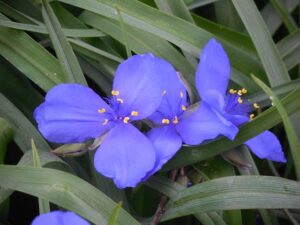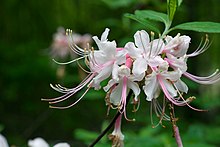
Greetings, readers. Today we learn about Peggy’s favorite flower, Spiderwort, as we continue her series about nature. Visit her website by clicking her name: Peggy Sias Lantz.
My Favorite Flower
by Peggy Lantz, author and naturalist
[See photos at the end.]In the winter, the Carolina jessamine climbs over the low trees, blooming profusely, full of inch-wide yellow blossoms that spread a light perfume. It was especially beautiful this winter.
But it’s not my favorite flower.
Right now, my Florida native azalea has burst into bloom. My bush has 100 blossoms on it – four-inches, pale pink and bright pink. It, too, has a lovely aroma.
But it’s not my favorite flower, either.
Spiderwort: beauty to share AND to eat
I think the flower I love the most is called spiderwort. They have gorgeous blue blossoms with one, two, or more on each stem. They bloom as soon as the sun is up, wide open, with yellow stamens above the blue petals. As the day moves on, the flower slowly closes until, by midday, it is a tiny blue button. If the day should be cloudy, it may last into the afternoon. Underneath the blue button is a golf ball-sized cluster of buds, waiting for their day to open.
Some varieties are paler, some more pink. Mine are bright blue and have spread and cultivated themselves, distributing themselves in great numbers in my yard near the driveway and front door. They bloom most of the year, morning after morning.
Clumps can be divided and replanted or shared with friends to share the beauty.
Spiderwort is a strange name for a plant. Wort is an old word for plant, and I suspect the spider part of its name is because its stem, when cut or broken, exudes a fluid that has properties similar to aloe that will ease the pain of a scratch or bug or spider bite.
It is also an edible addition to your dinner salad. Leaves, stems, and flowers all can be washed and put raw into the salad or added to cooked vegetables.
Its botanical name is Tradescantia ohiensis.
The botanical name of Carolina jessamine is Gelsemium sempervirens.
The botanical name of this native Florida azalea`is Rhododendron canescens.
—END—
Thanks for reading!
Your writer on the wing,
Charlene










Leave a Reply